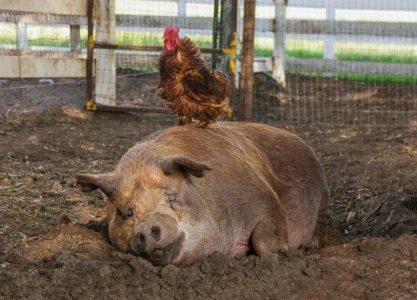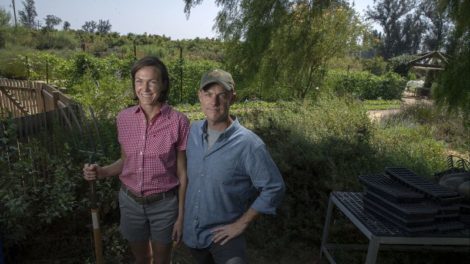The Biggest Little Farm
Tropic Sprockets by Ian Brockway
[mr_rating_result]Farmers John and Molly Chester are an exceptional couple. John is a National Geographic photographer, and Molly is a chef, specializing in organic foods. A documentary (directed by John) “The Biggest Little Farm” is the story of their experience in organic farming. This colorful and ebullient film has the tone and whimsy of an anthropomorphic Disney feature, yet it does not shy away from real life, especially in the realm of loss.
 The Chesters’ vision of a sustainable farm in harmony with humankind and nature originated in the attempts to help their hyperactive rescue dog, Todd who could not stop being destructive and barking. Todd needed a job and space to run.
The Chesters’ vision of a sustainable farm in harmony with humankind and nature originated in the attempts to help their hyperactive rescue dog, Todd who could not stop being destructive and barking. Todd needed a job and space to run.
The couple found 200 acres in Moorpark California, the foothills of Ventura County. But there was a problem: the soil was practically dead. Nothing had been growing there for years.
All was empty, dusty and dry.
Even the bees were dead, their desiccated bodies resembling vacant spacecraft.
Since soil is the life-blood of growth, they had to rebuild and start over. With a Djinn of diversity, Alan York, they did just that planting 10,000 orchard trees and 200 different crops.
The Chesters made a home for many animals. Pigs, goats, chickens and ducks all shepherded by several fluffy Great Pyrenees, happily panting.
But all was not harmonic.
Emma the pig suddenly gets a fever that refuses to vanish. The coyotes get scores of chickens and a legion of pests come in the form of flies, gophers and snails, as thick as pustules. More emotionally, Alan passes away and Mr. Greasy, the resident rooster and loyal boyfriend of Emma is incomprehensibly killed by one of the dogs.
 Then it hits John and Molly that in nature, there are checks and balances. To check the coyotes, they bring dogs, to check gophers, owls arrive. The natural world strives for neutrality, moderation or co-existence. All the Chesters have to do is embrace the wonder of uncertainty and the reality of impermanence—which leads to contentment—but this is not an easy condition.
Then it hits John and Molly that in nature, there are checks and balances. To check the coyotes, they bring dogs, to check gophers, owls arrive. The natural world strives for neutrality, moderation or co-existence. All the Chesters have to do is embrace the wonder of uncertainty and the reality of impermanence—which leads to contentment—but this is not an easy condition.
At Apricot Farms, there are no steadfast enemies. The goats kiss the cows, the chickens cluck calmly and even maggots portray a white benevolence. Every animal and element has a part to play.
Yet if one had to pick a favorite it would be Emma, nonchalant and jowly with a Zen equanimity.
As a real life Disney fable of what we all should celebrate, work for and be mindful of, this film celebrates nature, the soil, our food and friendships, both with the land and ourselves. While it touches on danger, it does not dwell upon it, pointing instead to the soil-laced dance of life in death and death in life. “The Biggest Little Farm” creates a prismatic permaculture, a testament to the animal and the human and it is a delight.
Write Ian at ianfree11@yahoo.com


Ratings & Comments
[mr_rating_form]